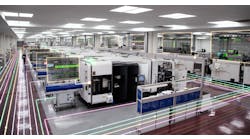Improve Your 'Visibility' for More Accuracy, Efficiency and Profitability
No battle plan has ever survived contact with the enemy—but a good battle plan is flexible enough to respond to changing conditions and deliver victory. Nobody knows this like the operations leader of a small- or mid-sized manufacturer.
You’re locked in a battle against chaos and the associated waste of materials and hours when your company’s quality and credibility with customers is on the line.
Of course, the better your view of the “battlefield,” the better will be the decisions you make as you schedule and manage the jobs that are your team’s lifeblood.
Here are three ways that improved visibility helps you deliver accuracy, efficiency and better profits for your manufacturing team:
Your ability to deliver often rests on agility. And nothing is less agile than a production system that depends on decision makers harvesting information from disparate sources: Conversations with the shop floor, emails, white boards, and hastily scrawled notes. Can we move up delivery two days on an in-process job? Can we deliver four more units in the same window on a different job—with my foreman on vacation?
Not being able to quickly see how changes in delivery, materials and time impacts the whole picture can quickly tie you in knots.
A single view of resource use – particularly on the shop floor — means fewer rush jobs, fewer mistakes and more efficient overall operation. When you can see exactly who is doing what — and which resources they’re using — you bring laser accuracy to capacity planning and give yourself the ability to anticipate the next bend in the road by adjusting personnel allocation. That’s the first payoff, which partially ties into the agility issue mentioned above. Secondly, when the shop floor team can record time and materials directly into the core system, you’re always on top of your budget thresholds. Which makes you the kind of ops leader every small- or mid-sized manufacturer wants: a profit enabler.
Many manufacturers are still working with different systems that require double entry – duplicating effort and increasing the risk of manual error. In response, they introduce labor-intensive processes, further increasing the effort. A single system for the entire operation means once a task is flagged complete, it can automatically help the business move to the next stage, generating paperwork and alerts as required. For example, when an estimate is approved, a sales order is automatically created; when production is finished, shipping is alerted and can spring into action.
Automating simple, essential transactions helps tie your operations together, optimize production, and free you to solve more interesting problems—ones that transports the manufacturing ops leader from “putting out fires” mode to “lean costs, happy customers and growing the business” mode.
Kelly Cabatuan is a sales manager at KeyedIn Solutions, Inc., a developer and supplier of cloud-based business management systems for manufacturers and those who manage distributed enterprises. Contact her at LinkedIn.













